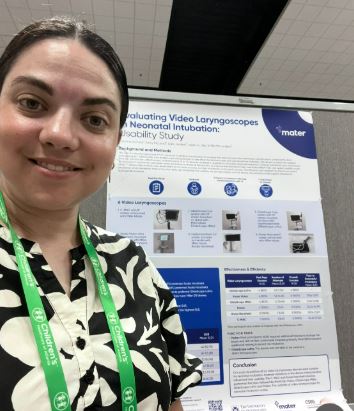We’re proud to share that the Video Laryngoscope Usability Study, led by PhD student, Dr Jasmine Antoine, under the supervision of Dr Mia McLanders of CSDS was recently presented on the international stage and published.
The study, conducted at CSDS in February 2023 with the support of Dr Mia McLanders, Dr Kirsty McLeod and Clinton Henderson was showcased at two major events in Honolulu, Hawaii:

- A poster presentation at the Pediatric Academic Societies (PAS) Conference – the largest paediatric meeting in the world.
- An oral presentation at the Neonatal Resuscitation Research Workshop – invitation only forum focused on advancing neonatal resuscitation science and improving outcomes for our most vulnerable patients.
Why this study matters
Placing a breathing tube into a newborn baby is a difficult procedure, with a high chance of failure and complications if not completed quickly and accurately. Traditionally, this was performed using a direct laryngoscope, a device that clinicians would insert into the mouth to look directly at the airway and guide a breathing tube into the trachea.
However, video laryngoscopes are now being used more frequently for newborn intubation. Video laryngoscopes are devices with a camera on the blade that, when inserted into the mouth, display a magnified view of the airway onto a screen, helping clinicians visualise the vocal cords and insert breathing tube into the trachea.
The use of video laryngoscopy in newborn intubation increases the chances of successful intubation on the first attempt and reduces the rates of complications. In addition, video laryngoscopy allows a shared airway view supporting supervision and training, and intubations can be recorded for training and debriefing
Measuring usability across devices
The study aimed to explore how design differences between video laryngoscopes impact their usability in simulation settings. It was hypothesised that the devices would vary in usability, measured through clinician satisfaction, efficacy, and efficiency.
To test this, consultant neonatologists evaluated six different video laryngoscopes using a term newborn manikin. Each device was assessed across three key domains:
- Clinician satisfaction – measured through preference rankings, the System Usability Scale (SUS), and the NASA Task Load Index (NASA-TLX) to capture perceived workload
- Efficacy – assessed by first-pass success rates, total number of attempts, and overall intubation success
- Efficiency – determined by time to successful intubation and the ability to complete function and troubleshooting tasks
What was found
In our study, the top-preforming devices were:
- Koala Handheld
- C-MAC
- GlideScope Miller
These were followed by:
- Koala Vision
- GlideScope LoPro
- Parker
Conclusion
These results reinforce a key message: device design matters. In high-pressure situations like newborn intubation, the right tool can make the procedure easier, safer, and more effective for both the clinician and the baby.
This project was designed in collaboration with Queensland Innovation Living Lab (QuILL) to enhance the care of our tiniest patients.









